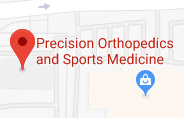What’s New in Hand Surgery?
Wrist Arthroscopy
Your wrist is a complex joint made up of eight small bones called carpal bones. These bones are supported by connecting ligaments. Various conditions can affect your wrist joint such as wrist fractures, ganglion cysts, ligament tears, and chronic pain. Wrist arthroscopy is a minimally invasive surgical procedure performed to view, diagnose, and treat problems of your wrist joint.
Wrist arthroscopy may be necessary to help in diagnosing:
- Stiffness
- Unexplained pain
- Swelling
- Giving way or popping of the joint
Wrist arthroscopy is also used to treat conditions such as:
- Arthritis
- Chronic wrist pain
- Wrist fractures
- Ligament tears and
- Ganglion cysts
Your doctor will make small 3 millimeter incisions, known as portals, on the back of your wrist. The portals are placed in specific locations on the wrist, depending on the areas that need to be visualized. The arthroscope and special surgical instruments are inserted into your wrist through these portals. The arthroscope is a thin tube with a camera, lens and light source. Your doctor will be guided by the images relayed from the arthroscope onto a video monitor throughout your procedure. Your doctor will perform any necessary repairs depending on your particular problem.
After the procedure, the portals are closed with small stitches and a dressing is applied. You may be instructed to wear a splint for a short time after the procedure.
Postoperative care
- Keep your hand elevated above the level of your heart for the first 2 to 3 days after your procedure
- Keep your bandage clean, dry, and intact
- You may apply ice over the operated area to reduce swelling and discomfort
- You will be instructed on special exercises to regain strength and mobility of your wrist
- You will be prescribed pain medications to relieve any pain
Recovery following wrist arthroscopy is generally more comfortable for the patient than an open surgery which requires a larger incision. There is usually less pain following the procedure and the healing time is faster when compared to an open procedure. Wrist arthroscopy is performed as a day surgery where most patients are able to go home within several hours after their surgery.
Complications are fairly rare with wrist arthroscopy. However, some of the possible complications that can occur include scarring, bleeding, swelling, infection, numbness and injury to adjoining structures.
2120 N. MacArthur Blvd
Suite 100
Irving, TX 75061
 Ph: (972) 438 4636
Ph: (972) 438 4636
 Fax:
(972) 438 2077
Fax:
(972) 438 2077

 Make an Appointment Online
Make an Appointment Online

 Shoulder
Shoulder Elbow
Elbow Wrist
Wrist Hand
Hand Patient Education
Patient Education Testimonials
Testimonials Map
& Location
Map
& Location Patient Forms
Patient Forms






